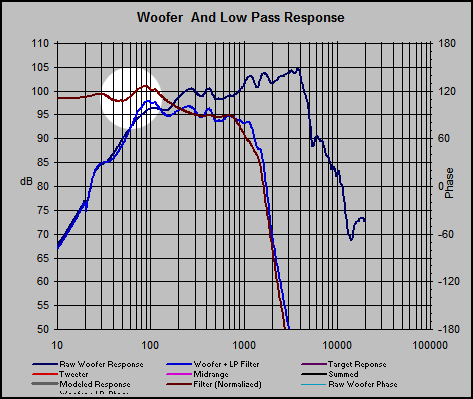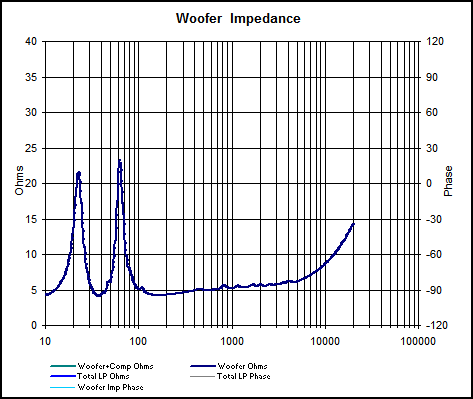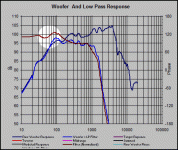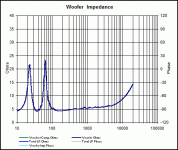I've got a speaker where I'd like to try a passive, baffle-step type of shelf filter very low, 180Hz to be exact. I knows there's other directions you might be tempted to take this discussion, but if everyone could please just take for granted that I want to try a shelf filter this low at speaker level here.. Consider it an experiment.
Now, the problem is that I only know of two ways to incorporate such a filter into the crossover, and they both start with a 2.5mH (or so) inductor in series (it's a 4Ω woofer). This creates a rather obvious problem with the woofer load, highlighted below. This graph shows measured woofer response, normalized filter response on measured load, and simulated filtered woofer response. The woofer response here is smoothed and gated, and not terribly accurate due to indoor limitations measuring LF, but the trend is valid to 100Hz, in order to show the step I'm trying to combat. The impedance is measured in a bass reflex enclosure, obviously.


Please disregard the blip at 110Hz (not to be confused with the larger ringing around 95Hz that this post is about). I can't recall if it was a noise issue I sometimes get with impedance measurements or if it was something going on with the cabinet at the time.
So, are there any sneaky ways of getting this shelf in a passive xover without being so messy?
Now, the problem is that I only know of two ways to incorporate such a filter into the crossover, and they both start with a 2.5mH (or so) inductor in series (it's a 4Ω woofer). This creates a rather obvious problem with the woofer load, highlighted below. This graph shows measured woofer response, normalized filter response on measured load, and simulated filtered woofer response. The woofer response here is smoothed and gated, and not terribly accurate due to indoor limitations measuring LF, but the trend is valid to 100Hz, in order to show the step I'm trying to combat. The impedance is measured in a bass reflex enclosure, obviously.
Please disregard the blip at 110Hz (not to be confused with the larger ringing around 95Hz that this post is about). I can't recall if it was a noise issue I sometimes get with impedance measurements or if it was something going on with the cabinet at the time.
So, are there any sneaky ways of getting this shelf in a passive xover without being so messy?
Attachments
Yes, but this particular project is getting a full active line level and/or DSP crossover. I am doing a fully-passive speaker-level version as well, just because. If this particular part of it proves to be something that can't be included, so be it, but that's my question. 🙂do it at line level
That would just make it worse. Some kind of resistive vent loading in the cabinet instead of bass reflex or sealed should help, but with this driver I'm pretty sure the result would negate any point to doing this in the first place... Not totally sure, I should probably look into that.Higher inductor resistance ?
I designed a large tower speaker (Snell XA Reference) with the same challenge, low crossover and strong interaction with the upper impedance peak. No trick but to conjugate out the upper impedance peak. The bad news is that it will take a big inductor (in the RLC), good news is that it can be a lower gauge wire since you can use the DCR of the coil for most of the needed R.
David S
David S
That's what they say about these low frequency ones but they're fine. As the impedance isn't too high, and as Dave is suggesting you should be good with one made with fairly thin wire (depending on your power needs) which should offer cost and size advantages. You could even possibly use smaller inductors you have already and stack them, building up the resistance and giving an inductance bonus.
- Status
- Not open for further replies.
- Home
- Loudspeakers
- Multi-Way
- Any tricks to getting away with too much inductance?

